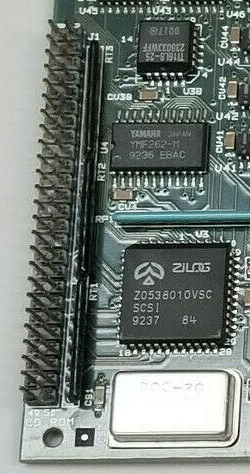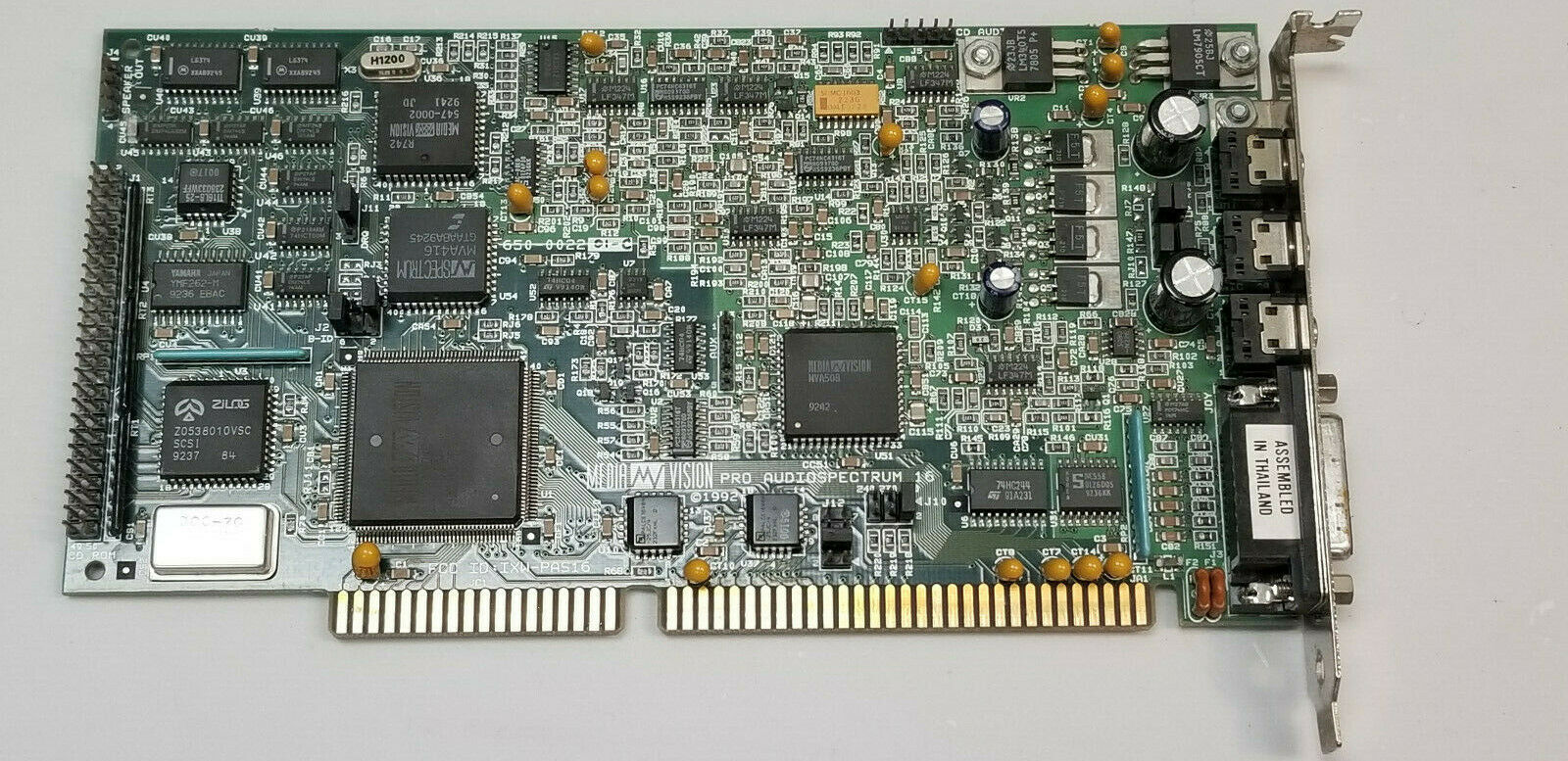Retro Review: Pro Audio Spectrum 16
November 17th 2021
Today's retro review focusses on a new sound card I picked up this week - MediaVision Pro Audio Spectrum 16.
MediaVision Pro Audio Spectrum 16
Bought in November 2021 for $65 USD
The PAS16, as it's often abbreviated, was launched in 1992 - about a year after the original Pro Audio Spectrum. It was an improvement on its forebear in that it provided 16-bit 44.1 KHz CD-quality digital audio recording and playback capability, much like the Sound Blaster 16 did over the Sound Blaster Pro. MediaVision actually beat Creative Labs to market by just one month in releasing this card as the very first 16-bit audio quality PC sound card.

An advertisement for the Pro AudioSpectrum 16 in June 1992
While the original PAS card was not Sound Blaster-compatible [well... it was, but only via software emulation], MediaVision fixed this shortcoming with subsequent cards, the PAS Plus and PAS 16, by including their Thunder Board chipset on these cards. The Thunder Board was their first sound card and was Sound Blaster 1.5-compatible. This meant that the PAS16 actually had two hardware audio devices onboard, with both being able to run simultaneously - the analog output of both are mixed using the on-board mixer circuitry:
- Thunder Board - for Ad Lib and Sound Blaster 1.0 and 1.5 support (mono only)
- Pro Audio Spectrum - for actual Pro Audio Spectrum support
MediaVision's cards were rated very highly by the press for their build quality and more importantly, their low noise when compared to their Sound Blaster competitors - around -90dB signal-to-noise ratio with a total harmonic distortion of 0.05%. This was partly down to the excellent 4-layer PCB with very large ground plane to keep electrical noise to a minimum.
There are really just two limitations with the PAS16, which are:
1) No Sound Blaster Pro digital audio support, but does of course support the stereo FM music of the Sound Blaster Pro because it uses the exact same Yamaha OPL3 chip.
2) FM music when running a game in Pro Audio Spectrum (non-16) mode or "early" Sound Blaster Pro mode was in mono only, since the OPL3 chip can only emulate one YM3812 chip, not two.
PAS16 Revisions
There were a good number of variants of the Pro Audio Spectrum 16. This table lists them in what I believe to be chronological order of release. Mine here is the first one on the list:-
| Card Identification | CD-ROM | DMA Sharing | Aux-In | Jacks | Other Board Changes from the previous revision |
|---|---|---|---|---|---|
| IXW-PAS16, Part #650-0022-01 (on the rear: 600-0022-01 Rev.F) | SCSI | Yes | Yes | Line-In (stereo) Line-Out (stereo) Mic-In (mono) |
First release. Board ID jumpers (J2) near codec chip, SB Port address jumper (J10), SB IRQ setting (J12), SB DMA sharing jumper (J11), PC Speaker-out (J4) in top-left, Aux-in (J13) |
| IXW-PAS16SL, Part #650-0032-04K or -04I | Sony | - | Yes | Line-In (stereo) Line-Out (stereo) Mic-In (mono) |
MVD101 chip now up to Rev.D (see notes below), Board ID jumpers (J2) moved down near edge connector, Port Address and IRQ jumpers for SB emulation removed (now done in S/W) |
| IXW-PAS16P, Part #650-0042-01L or -01B | LMSI | - | Yes | Line-In (stereo) Line-Out (stereo) Mic-In (mono) |
Removed logic chip and resistor pack near YMF262, unique jumpers for the LMSI CD-ROM near its connector |
| IXW-PAS16SL, Part #650-0044-01 | Sony | - | Yes | Line-In (stereo) Line-Out (stereo) Mic-In (mono) |
No material difference from 0032. |
| IXW-PAS16, Part #650-0044-01F or -01P | SCSI | - | Yes | Line-In (stereo) Line-Out (stereo) Mic-In (mono) |
No material difference from 0032. |
| IXW-PAS16NS, Part #650-0044-01Q or -56B or -56G | SCSI | - | Yes | Line-In (stereo) Line-Out (stereo) Mic-In (mono) |
SCSI controller changed from Zilog to Logic LS380JC. Thunder Board chip moved to top-left and YMF262 moved down. |
| IXW-PAS16LL, Part #650-0053-02E or -52A - OEM version incl. Logitech SoundMan | - | - | - | Line-In (stereo) Line-Out (stereo) Mic-In (mono) |
No CD-ROM interface means a shorter board. No Board ID jumpers (pads only), no AUX-In, speaker-out moved beside CD Audio-In - some have just solder pads. |
| IXW-PAR, Part #650-0060-13B or -52A or -52D or -53B or -60A | SCSI | Yes | - | Spk-Out Line-In (stereo) Line-Out (stereo) Mic-In (mono) |
Board ID jumpers (J2) moved further right, DMA sharing jumper (J16), no AUX-in, no Speaker-Out |
| IXW-SCSI 1-1, Part #650-0097-05 | SCSI | Yes | - | Line-In (stereo) Line-Out (stereo 1W) Mic-In (mono) |
Board ID jumpers (J3) moved to centre of board, just above MVD101D, DMA sharing jumper (J4), no AUX-in, no Speaker-Out |
 The first Pro Audio Spectrum 16 variant to hit the market, 650-0022-01 Rev.C could be purchased separately but it was also bundled in a "Multimedia Kit" which was common at the time as the wave of 'multimedia' hit. These kits gave you everything you needed to upgrade your PC to the new magical world of multimedia including a SCSI CD-ROM drive, a PAS16 card, and some bundled software. The bundled CD-ROM drive was interesting in that it was one of the more rare types that ejected a 'caddy' into which you put the disc, rather than just opening a tray.
The first Pro Audio Spectrum 16 variant to hit the market, 650-0022-01 Rev.C could be purchased separately but it was also bundled in a "Multimedia Kit" which was common at the time as the wave of 'multimedia' hit. These kits gave you everything you needed to upgrade your PC to the new magical world of multimedia including a SCSI CD-ROM drive, a PAS16 card, and some bundled software. The bundled CD-ROM drive was interesting in that it was one of the more rare types that ejected a 'caddy' into which you put the disc, rather than just opening a tray.
Because it was a SCSI drive, the connector on the card is a 50-pin one (see left), along with a dedicated SCSI controller chip - in this case the Zilog Z0538010VSC, which is a clone of the NCR 5380. While for the PAS16, it is designed for CD-ROM drives, it can be made to work with other SCSI devices in Windows 95/98 such as SCSI hard drives, removable/erasable optical drives and removable cartridge drives.
This was the only board revision where you set the Sound Blaster base address (J10) and IRQ setting (J12) via jumpers. From the factory J10 was set to 220h and J12 was set to IRQ 5 (pins 3-4 closed).
The second variant, 650-0032-04 came with a Sony CD-ROM interface (also sometimes called SLCD) instead - this was also sold as part of several multimedia kits from Media Vision including the Family Deluxe MV2000 and Family Deluxe MV2001, both of which came with a SONY 33A drive, and the Fusion CD16 which came with a Sony CDU-31A drive.
The third variant, 650-0042-01 came with the rare and short-lived LMSI CD-ROM interface (Laser Magnetic Storage Interface). This was sold separately or as part of the Fusion CD16 multimedia kit which came with a Philips drive. A later variant also got the LMSI interface, 650-0082-03 which was also bundled with a Philips LMSI 206 drive as the Double Fusion LX, Sam's MM Double CD 16 and Software Etc MM Double CD 16 kits.
The fourth variant, 650-0044-XX retained the original SCSI CD-ROM interface and was sold separately or in various multimedia kits including the Fusion CD16E and Sam's Multimedia CD16 Kit (both 650-0044-01 and with either NEC 25 BJ or MV2 CD-ROM drive), Family Deluxe MV2000/MV2001 and Media Vision Resources Fusion LX kit (both 650-0044-06), and finally in the MV1001 kit (650-0044-56).
Next up was a cost-reduced model, 650-0053-XX, made for the OEM market which was pared down with no CD-ROM interface, and no other niceties. It was called the Pro Audio Spectrum 16 Basic. This was also sold to third parties - the Logitech SoundMan 16 was one of these, 650-0053-52A.
The 650-0060-XX models were marketed as the Pro Audio Studio. It added a separate unamplified stereo line-out jack, but, like the cost-reduced model above, lost the aux-in feature. Like earlier variants, you could buy it separately or as a bundle including the Family Deluxe MV3000 or MV3001 kits (650-0060-03). The 0060-52 and 0060-53 variants were only sold separately. There was also a 0060-02 variant which was sold by Sigma Designs as part number 53-00296 - this got both a Sony and SCSI CD-ROM interface onboard.
Finally, 650-0097-05 cards were bundle-only. The kits with these cards were called Family Deluxe MV3000, Family Deluxe MV3001, MV1000 (with Sanyo CD-ROM drive), and Pro CD III (with NEC 510 triple-speed CD-ROM drive).
Look out for the upcoming Part 2, where I take a look at the hardware itself!

